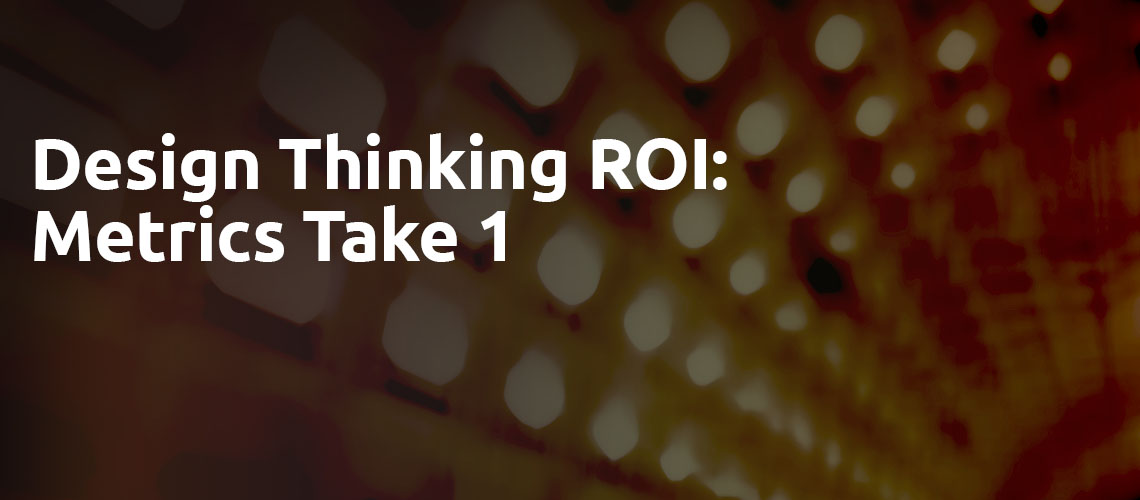
Measuring the ROI of Design Thinking and developing a structure for metrics is still very much a work in progress. Two studies one from McKinsey and the other from Jeanne Liedtka of the Darden School of Management at the University of Virginia provide solid evidence that Design Thinking does make a significant difference to the outcomes of an organization whether you are measuring the hard (a successful product, service or experience)or soft (More efficiency, better alignment, a different level of conversation about what to make) results.
The McKinsey study shows that organizations that use Design(ers) in a strategic way perform twice as well as those who do not. NOTE: This research studied the use of design, not design thinking. Design thinking is the use of a designers way of thinking about problem solving, so it stands to reason that using the same methodology would make some improvement as well. Not twice of course as that would require the actual skills and finely honed craft that designers bring to the table to achieve that.
Liedkta's study goes into a lot more depth and demonstrates that perhaps the soft influences of using design thinking are even more important than or in addition to the hard results. Mural, have a great summary of Jeanne Liedtka's webinar talk discussing her research and framework to measuring the success of Design Thinking projects. This is well worth spending some time on so that you can see what factors you could actually measure.
Liedtka mentions four levels of outcome that Design Thinking projects can achieve, starting with the most obvious outcomes.
- Changes in hard measurable outcomes (better products/services or experiences).
- Measurable changes in perception.
- Changes in the conversation.
- Changes in how people think.
Many people are starting to think, and research is backing this up, that some of the more lasting impacts of Design Thinking are not the hard output of the process, but rather the soft opinion/behavioral changes that it brings to organizations. Liedtka's research certainly backs this up. Following such a line of thinking would definitely be beneficial for the practice of Design Thinking and perhaps set some more realistic expectations about the outcomes of Design Thinking projects for organizations.
Watch Jeanne Liedtka's Webinar with Mural to understand her ideas and measurement framework in more detail. Her research also points out the ideal outcomes that organizations are looking for.
Corporations would like
- A better set of choices
- Decreased risk and investment
- Increased chances of ideas being implemented
- Enhanced organizational adaptability
How individual elements of Design Thinking Contribute
- Search for a deep understanding of user context and needs
- Heterogeneity of teams
- Dialog based conversations
- Multiple solutions winnowed through small experiments
- Creation of a structured and facilitated process (and the value it creates)
Perhaps one of the most important outcomes of the study points to the goal of Design Thinking's role of helping organizations innovate better and that is that "structure" does not inhibit creativity, instead if frees it up to become more effective. This is backed up by similar conclusions that Larry Keeley of the Doblin group, another expert in Innovation, has identified: Innovation attempts usually fail because of a lack of discipline he found, not usually because of a lack of creativity. The Design Thinking process and Keeley's work bring a strong sense of discipline to the innovation process, especially around the activity of correctly identifying needs and the right problem to be solved as opposed to the problem people are conditioned to see when they work in a particular sector. Discipline it seems has many beneficial results, from better aligning the members of the team, ensuring that they were focused on the right problem to solve, got to know and understand their users well before trying to find a solution and last but not least, failing fast and iterating quickly to reduce cost and advance the concept and desirability to the users much more efficiently.
Did your project succeed?
When you are setting up your evaluation criteria for the project in the planning phase before work begins, make sure to ask the hard and soft questions as Liedtka has above. Score each question on a scale of 1-5 so that you end up with a final percentage. In this way you can make it a lot more clear to the leadership what outcomes were achieved. In Liedtka's Webinar, she presents a great framework that you might want to start with for your metrics and then customize it for your specific purpose from there.
